The intelligence war against the Montenegrins
Photo: Soon to be assassinated Yugoslav diplomat and former intelligence office Vladimir Rolovic (left), with Yugoslav Labour Minister Anton Polajner (centre) and Australian Federal Minister for Labour and National Service (Sir) Billy Snedden share a friendly drink, Canberra, Australia 1970 during an official visit. source: National Archives of Australia
Vladimir Rolovic (left), Anton Polajner (centre) and Gjoko Sekulovski, Yugoslavia’s Ambassador to Australia (1967-70) visit Captain Cook’s Cottage in Melbourne in 1970. According to an ASIO report, Sekulovski asked and was given permission by the Australian authorities in 1969 to have a Yugoslav intelligence officer (UDBa) operate on Australian soil and liaise with Australian counterparts to combat “Croatian terrorism.” For reasons unknown Yugoslavia could not find a suitably qualified UDBa officer who could speak English very well. This raises the question was Yugoslavia serious about the Croatian threat?
——————————————————————————————————————————————–
TEAM UZUNOV exclusive:
A Rockin’, Rolovich-ing and a Rover-ing:
Sex, microphone bugs, rock’n’roll, & Yugoslav spying in Australia and Europe in the 1960s & 70s.
by Sasha Uzunov
The 1971 assassination by Croatian nationalists of Yugoslav Ambassador to Sweden, the Montenegrin Vladimir Rolovic, was an open and shut case. Or was it? Was there an Australian connection?
In April 1971 two Croatian nationalists, Miro Baresic and Andjelko Brajkovic, walked into the Yugoslav Embassy in Stockholm, the capital of Sweden, and Baresic shot the Yugoslav Ambassador and former intelligence officer Rolovic, who died days later of his wounds.
Baresic and Brajkovic, both members of the Croatian National Resistance (Hrvatski Narodni Otpor-HNO), surrendered to Swedish authorities and served prison time before being released in exchange when a Swedish domestic aeroplance was hijacked by Croats. Baresic eventually found himself in Paraguay, South America, as a government “security expert” before returning to fight in Croatia’s War of Independence in 1991 against Yugoslavia. But was killed in combat that same year.
Recently, the nephew of Rolovic, Miodrag Ilickovic, himself a former Yugoslav diplomat and now living in Australia after being granted political asylum, gave an interview to TEAM UZUNOV, to offer the other side in the story that TEAM UZUNOV has been following, that of Yugoslav spying in Australia of emigre Croats and Macedonians. Our documentary film UDBa Down Under, which details Yugoslav spying in Australia is due for release in early 2013.
We have detailed in previous blogs how Yugoslav intelligence (UDBa) waged a dirty tricks campaign to discredit Croats and Macedonians. For the sake of fairness, whether you agree or disagree with Ilickovic’s assertions, we allow him a chance to offer his version on the killing of his uncle.
Ilickovic (pictured above), a Montenegrin who is is now living in Australia after being granted political asylum because of his opposition to Serbian leader Slobodan Milosevic, has written a manuscript and is trying to get it published as a book in English or Serbian.
His manuscript is titled
Uloga Australije u Razbijanju Jugoslavije
-Australia’s role in the destruction of Yugoslavia-
Ilickovic’s main thesis is that Australia played a leading part in the collapse of communist federal Yugoslavia.
Ilickovic was posted to the Yugoslav Consulate in Sydney in 1990 and was tasked in reopening it after it had been closed down for 2 years by the Australian government–a 16 year old Croat protester Josip Tokic whilst climbing a wall was shot by a consular guard in 1988. Ilickovic accused the Australian authorities, in his manuscript, of inadequate security, whilst the Australian media at the time condemned the Yugoslav government for the shooting.
Ilickovic argues in his memoirs that Australia gave postwar sanctuary to Croat nationalists who served with the pro-Nazi Ustasha movement during World War II in Balkans, and alleges the Australian Security Intelligence Organisation (ASIO), the domestic counter-intelligence service, turned a blind eye to anti-Yugoslav activities and “terrorism” by Croats launched from Australia.
He asserts that a leading Australian-Croat activist Srecko Rover, with alleged ASIO backing, was involved in coordinating from Australia the assassination of Vladimir Rolovic in 1971.
Rolovic was in Australia in early 1970 as part of a Yugoslav government delegation headed by Yugoslav Labour Minister Anton Polajner. According to Ilickovic, his uncle Rolovic handed over a list of names of “Croatian terrorists” to the Australian authorities, included in that list was Rover’s name.
ASIO files reveal that Rover visited the Americas and Europe, including Sweden, in late 1970 (see document further down the page).
However, controversial Commonwealth Police Officer, Superintendent Kerry Milte, spoke to Rover over alleged threats made during the Polajner/Rolovic visit. This is page 1 of 3 (below).
Rover tells Milte: “You must have the wrong information about me. I’m always being blamed for these things.”
He adds: “I would really like you to phone ASIO, because they know all about me.”
The other two pages outline Rover’s political beliefs and denial in any wrongdoing. Milte went on to become infamous in the Murphy Raid on ASIO Headquarters in 1973 over “Croatian terrorism” on Australian soil.
What complicates this story is the Yugoslav Communist government in the early 1970s did not follow through on its own security proposal to combat “Croatian terrorism” on Australian soil, despite Australia agreeing to the proposal.
The proposal dating back to 1969 and first raised by then Yugoslav Ambassador to Australia, Gjoko Sekulovski (pictured above wearing glasses), and repeated in early 1970s included the sending of a Yugoslav intelligence (UDBa) officer to Australia to exchange information on “Croatian terrorists” with the Australian Security Intelligence Organisation (ASIO) and the Commonwealth Police Force (the forerunner of the Australian Federal Police).
A search of ASIO records, including those already publicly released into the National Archives of Australia, has turned up nothing on Rolovic except a travel file, which was inexplicably destroyed on 22 August 2002. The question is why was this document destroyed?
A number of photos from the 1970 visit are on record with the National Archives of Australia.
Other explosive claims made by Ilickovic in his manuscript Uloga Australije u Razbijanju Jugoslavije
-Australia’s role in the destruction of Yugoslavia-:
–Thousands and thousands of files were kept on Australians hostile to the Yugoslav government and were seen by Ilickovic who found them in the Sydney consulate in 1990;
–Australian politicians and diplomats sympathetic to the Yugoslav regime passing on sensitive information to Belgrade; and
—In one example, two large sacks full of ASIO documents were handed over by “Australian friends” and given to Yugoslav Embassy official Bogoljub Rađenović–Rađen and taken away in the boot (trunk) of a car and sent to Belgrade via the diplomatic pouch.
BACKGROUND
Yugoslavia was a multi-ethnic communist federation founded in 1945, modeled on the Soviet Union, and fell apart in 1991 into various independent nation states of Croatia, Serbia, Macedonia, Slovenia, Montenegro, and Bosnia-Herzegovina and Kosovo.
Yugoslav intelligence (UDBa) later known as SDB, together with Yugoslav military counter-intelligence (KOS) were largely pre-occupied with silencing dissident Croats, Macedonians, Serbs and Albanians living in Western Europe, North America and Australia, who were agitating for independence from Yugoslavia.
UDBa was so ruthless and efficient it at one time rivaled the old Soviet KGB in liquidating opponents.
Communist strongman Marshal Josip Broz Tito ruled Yugoslavia until his death in 1980 and during the height of the Cold War managed a great balancing act between East and West. He was seen as an indirect ally of the West after his infamous split with Soviet dictator Josef Stalin in 1949.
A number of Australian left-wing politicians, including Victorian State MP Joan Coxsedge, began to allege that ASIO was turning a blind eye to extremist Croatian elements, who were secretly training on Australian soil to undertake terrorist attacks on Yugoslav territory or upon Yugoslav diplomatic missions in Australia.
In this atmosphere of terrorism mania during the 1970s Australia’s Croat community were looked upon as the bad guy.
No doubt this was not helped by the fact that a sizeable number of Croats, known as Ustashas, during World War II had collaborated with the Nazis. However, a large number had also fought against the Nazis as Partizans, including Franjo Tudjman later to become President of independent Croatia in 1991. Likewise, a large body of Serbs had served with the Royalist Chetniks led by Draza Mihailovic and were accused of Nazi collaboration, as well as their being a quisling Serbian government under General Nedic. And a big number of Serbs also served as Partizans.
But UDBa began to target the émigré Macedonian community in Australia, which had no history of large-scale Nazi collaboration, in fact the opposite, but had grown disillusioned with Yugoslavia over the rise of Serbian nationalism with the advent of the Slobodan Milosevic regime.
However, ASIO was deeply concerned about a schism that had developed within dissident Croatian ranks abroad, namely Australia and Western Europe in the 1970s.
A 1971 assessment paper for ASIO and the then Commonwealth Police–declassified and in the National Archives of Australia– raised concerns about a faction headed by the mysterious Dr Branimir “Branko” Jelic, a Croat right wing nationalist living in West Germany who believed that an independent Croatian homeland could only break away from then communist Yugoslavia with assistance from the Soviet Union.
In 1972 Dr Jelic, Moscow’s man, was assassinated by UDBa, the Yugoslav Secret Police, and no doubt Washington would have looked the other way, as the enemy of my enemy is my friend !
A rivalry developed between Yugoslavia and the Soviet Union, which Tito managed to use to his advantage by squeezing aid out of the West in order to stay out of the Soviet Camp.
But Tito was also adept at cosing up to the USSR when it suited him, especially after the death of Soviet dictator Joseph Stalin in 1953.
In the early 1970s the Yugoslav government began a campaign to discredit emigre Croats, Macedonians and others opposed to the regime, whether their opposition translated into terrorism or just peaceful means. So a dirty tricks strategy was commenced with agent provocateurs and infiltrators, ironically learned from the Soviet Secret Police Cheka/OGPU/NKVD/KGB.
The Moscow faction within the Croat dissident community remains a touchy and mysterious subject. It is hard to know whether it was genuine Soviet interference or another fiendish double cross thought up by Belgrade.
However, the importance is that the West, and in particular ASIO, believed in the Soviet plot. There were genuine threats against communist Yugoslavia but it is difficult to untangle which ones were real, which ones were manufactured by UDBa.
The Yugoslav government had complained long and hard and loudly to western governments to combat “international Croatian terrorism.” Many experts such as Dr John Schindler agree that UDBa rivalled the American CIA and the Soviet KGB in ruthless efficiency.
ONE MAN’S TERRORIST IS ANOTHER MAN’S FREEDOM FIGHTER
A source within Australia’s Croatian community has told TEAM UZUNOV that it was highly unlikely that Rover played any part. “Baresic was the real deal,” he said.
But the source made the point that if Rover did take part then he would be regarded as a hero. “It’s that old line of one man’s terrorist is another man’s freedom fighter,” the Croat source said. “It depends where you sit, pro-Yugoslav or pro-Croat.”
Leading Australian journalist Jack Waterford (pictured below), a former student activist during the late 1960s and no friend of ASIO, believes that Rover was not a serious threat but was placed under ASIO surveillance because of a fear, as it turned out unfounded, that he may have fallen under the influence of the Soviets.
ASIO compiled more than 10,000 pages in many volumes of files, including phone wire taps, on Melbourne-based Australian-Croat leader Srecko Rover beginning with his biography: his military service with the extreme right wing Ustasha during World War II, his split with Ustasha leader Ante Pavelic, his alleged links to the Soviets–which proved unfounded; ASIO’s surveillance of Rover’s movements, including how many miles/kilometres he drove in his car, even his private romantic life and the 1966 attempt on his life by disgruntled fellow Croat Vlado Pernar. There are conflicting reports in the files: Rover was accused of terrorism and bombings against Yugoslav diplomatic missions; and other reports say he was not involved. He remains an enigma. Prominent Australian Left author and journalist Mark Aarons accused Rover of being a Nazi war criminal, which Rover denied and blamed the Yugoslav regime for trying to discredit him. No Australian court ever prosecuted Rover.
ASIO kept tabs on Rover’s travels abroad in 1970, including his visit to Sweden. In 1972 his Australian passport was cancelled by the government. One report also accuses Rover of terrorism; another dismisses it. An intelligence rivalry developed between ASIO and the Commonwealth Police over who could manage the Yugoslav-Croat dispute in Australia during the Cold War.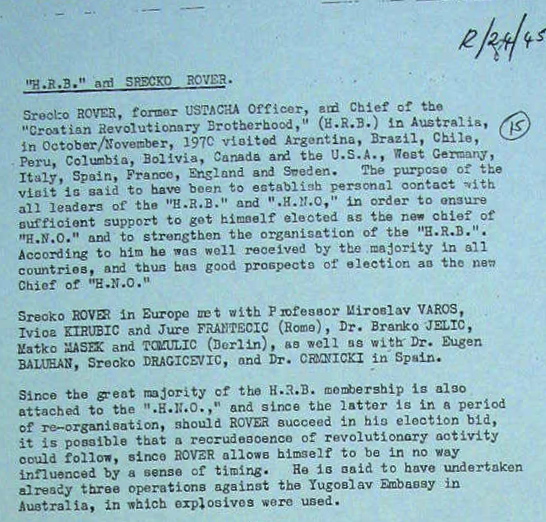
The Commonwealth Police (the forerunner of the Australian Federal Police) claimed Rover had gone Red by joining Jelic’s pro-Moscow Croats. But this was later contradicted by a 1972 ASIO report which revealed the dislike between Rover and Jelic.
The 1966 attempt on Srecko Rover’s life by Vlado Pernar who pleaded guilty to a lesser charge of wounding with intent to do grievous bodily harm. Victorian Supreme Court, Melbourne, Australia.
———————————————————————————————————————————-
1975 DAPCEVIC KIDNAPPING
The daring kidnapping of Montenegrin dissident Vladimir “Vlado” Dapcevic by UDBa on Romanian soil in 1975 highlighted the cosy intelligence partnership that had developed in the 1970s between Tito’s Socialist Federal Yugoslavia and Ceausescu’s Communist Romania (photo below).
We now know the workings of this operation because of the memoirs of ex-Romanian spy chief Ion Pacepa, who detailed it in his book Red Horizons after defecting to the United States in 1979.
Dapcevic (1917-2001), the brother of Yugoslav Partizan hero and Army General Peko Dapcevic, had risen through the ranks of Marshal Tito’s Yugoslavia but sided with the Soviet Union when Tito broke off from Moscow’s orbit in 1949. Dapcevic did prison time before eventually arriving in the Soviet Union via Albania. He left the Soviet Union in the mid 1960s and lived in Western Europe before being lured to Bucharest, the Romanian capital, in 1975, where an UDBa (Yugoslav intelligence) team, some posing as athletes, kidnapped and smuggled him across the border into Yugoslavia.
Ion Pacepa (far left) pictured with US Secretary of State Henry Kissinger during a visit to Washington in the early 1970s.
According to Pacepa’s book, Tito tells Ceausescu that he needs to neutralise Vlado Dapcevic.
Vlado Dapcevic was imprisoned until 1988 and was probably saved from execution by the fact his older brother Peko remained loyal to Tito.
World War II Montenegrin Partizan Hero and Yugoslav People’s Army (JNA) General Peko Dapcevic (1913-99) chose loyalty to Marshal Tito over his younger bother and political dissident Vlado Dapcevic. Photo source: Wikipedia

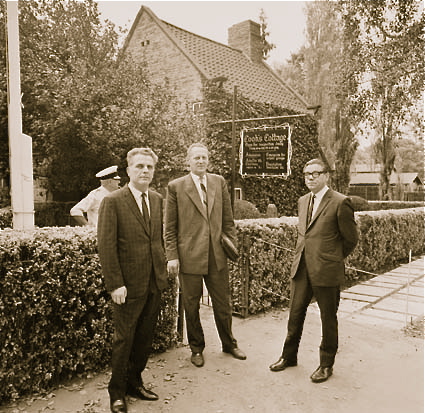





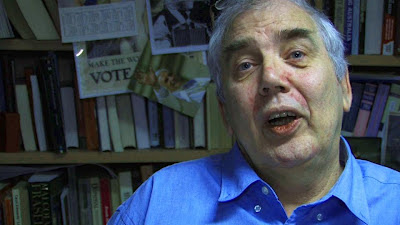


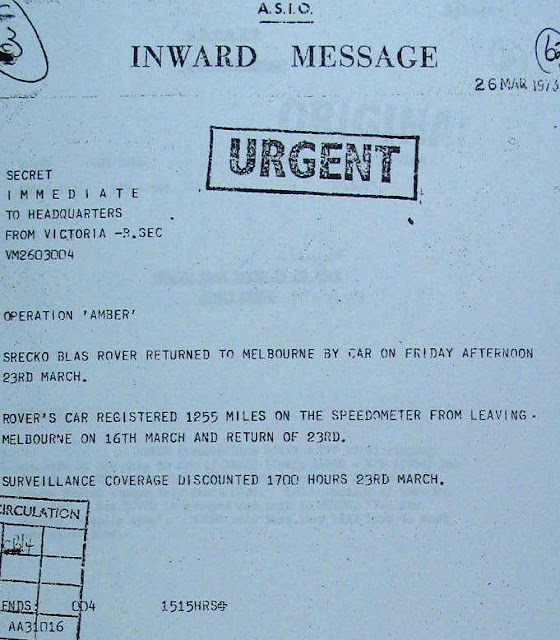


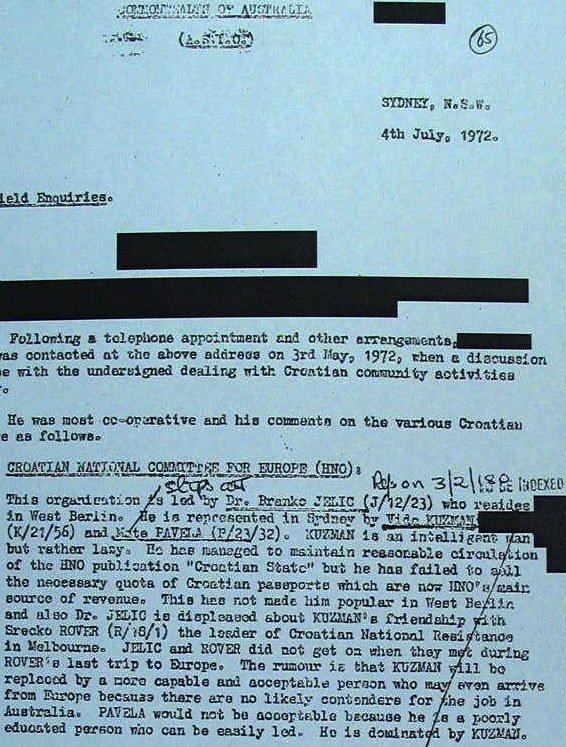





This comment has been removed by a blog administrator.
So, new Croatian state didn’t act on lustration of agents of ex Yugoslav police and their collaborators, in the country, and those who acted abroad among emigration. At the beginning of the war, lots of former collaborators of SDS from emigrations and former collaborators of foreign secret services, CIA, BND, MI6, BND, French intelligence services. All of them Franjo Tuđman took in his service, knowing about their past and believing him, they were loyal to him. http://en.45lines.com/croatian-secret-services-need-lustration/